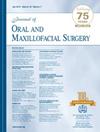Open Versus Closed Management for Gunshot Wounds of the Mandible – Which More Frequently Achieves Satisfactory Bony Union? A Systematic Review and Meta-Analysis
IF 2.3
3区 医学
Q2 DENTISTRY, ORAL SURGERY & MEDICINE
引用次数: 0
Abstract
Purpose
Closed management of high-energy mandibular injuries has been considered the gold standard for many years, but open management is preferable for its shorter overall treatment time. At present, there is a paucity of evidence on which to base management decisions, and as such there is a priority to review the literature to define the optimal treatment for mandibular gunshot wounds (GSWs).
Method
The study design was a systematic review with meta-analyses and the protocol was designed in accordance with the Preferred Reporting Items for Systematic Reviews and Meta-Analysis statement. Electronic searches of published literature in the MEDLINE and Embase databases (1980-present) were conducted. Search terms included “gunshot”, “firearm”, “mandible”, and “jaw”. Inclusion criteria were randomized controlled trials (RCTs), cohort studies, case-control studies, and case series written in English describing studies involving patients with mandibular fractures caused by GSWs [population] containing information on treatment by either open reduction and (nonwire) internal fixation [intervention] or by closed reduction ± external fixation [comparator], and the frequency of bony union and complications [outcomes]. Meta-analysis was conducted using the Mantel-Haenszel odds ratio (OR) as the measure of effect. The quality of evidence was assessed using the Cochrane Risk of Bias 2 tool for RCTs and the Newcastle-Ottawa Scale for observational studies.
Results
159 studies were identified overall of which 6 studies (3.7%; 3 observational studies and 3 RCTs) met the eligibility criteria. Due to high heterogeneity the study subtypes were analyzed separately. In the observational studies (n = 137), open management resulted in bony union 43/52 (82.7%) times, whereas closed management resulted in bony union 78/85 (91.8%) times (OR 0.40, 95% CI 0.14 to 1.15, P = .09). In the RCTs (n = 190), open management resulted in bony union 89/95 (93.7%) times, whereas closed management resulted in bony union 70/95 (73.7%) times (OR 6.86, 95% CI 2.42 to 19.46, P = .0003).
Conclusion
The practicalities of treating mandibular GSWs are nuanced, and the recommendation of a one-size-fits-all management approach would be inappropriate. However, there is sufficient evidence in the findings of this systematic review to support open management as first-line treatment, with closed management considered if the former is clinically or logistically unfeasible.
开放与封闭治疗下颌骨枪伤-哪一种更容易获得满意的骨愈合?系统回顾和荟萃分析。
目的:多年来,闭式治疗被认为是治疗高能量下颌骨损伤的金标准,但开式治疗因其整体治疗时间较短而更可取。目前,缺乏作为管理决策基础的证据,因此,优先审查文献以确定下颌枪伤(GSWs)的最佳治疗方法。方法:本研究设计为系统评价和荟萃分析,方案按照系统评价和荟萃分析的首选报告项目设计。对MEDLINE和Embase数据库中发表的文献(1980年至今)进行电子检索。搜索词包括“枪击”、“火器”、“下颌骨”和“下巴”。纳入标准是随机对照试验(RCTs)、队列研究、病例对照研究和用英文撰写的病例系列研究,这些研究描述了由GSWs引起的下颌骨折患者[人群],其中包括开放复位和(非丝)内固定治疗[干预]或闭合复位±外固定治疗[比较]的信息,以及骨愈合的频率和并发症[结局]。meta分析采用Mantel-Haenszel优势比(OR)作为效果度量。证据质量采用随机对照试验的Cochrane风险偏倚2工具和观察性研究的Newcastle-Ottawa量表进行评估。结果:共纳入159项研究,其中6项研究(3.7%;3项观察性研究和3项随机对照试验符合入选标准。由于异质性高,研究亚型分别进行分析。在观察性研究中(n = 137),开放治疗的骨愈合率为43/52(82.7%)次,而封闭治疗的骨愈合率为78/85(91.8%)次(OR 0.40, 95% CI 0.14 ~ 1.15, P = 0.09)。在rct (n = 190)中,开放治疗的骨愈合率为89/95(93.7%)次,而封闭治疗的骨愈合率为70/95(73.7%)次(OR 6.86, 95% CI 2.42 ~ 19.46, P = 0.0003)。结论:治疗下颌骨GSWs的可行性存在差异,不宜采用一刀切的治疗方法。然而,在本系统综述的发现中有足够的证据支持开放式管理作为一线治疗,如果前者在临床或后勤上不可行,则考虑封闭式管理。
本文章由计算机程序翻译,如有差异,请以英文原文为准。
求助全文
约1分钟内获得全文
求助全文
来源期刊

Journal of Oral and Maxillofacial Surgery
医学-牙科与口腔外科
CiteScore
4.00
自引率
5.30%
发文量
0
审稿时长
41 days
期刊介绍:
This monthly journal offers comprehensive coverage of new techniques, important developments and innovative ideas in oral and maxillofacial surgery. Practice-applicable articles help develop the methods used to handle dentoalveolar surgery, facial injuries and deformities, TMJ disorders, oral cancer, jaw reconstruction, anesthesia and analgesia. The journal also includes specifics on new instruments and diagnostic equipment and modern therapeutic drugs and devices. Journal of Oral and Maxillofacial Surgery is recommended for first or priority subscription by the Dental Section of the Medical Library Association.
 求助内容:
求助内容: 应助结果提醒方式:
应助结果提醒方式:


